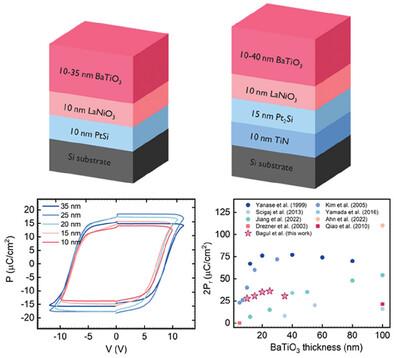当前位置:
X-MOL 学术
›
Adv. Electron. Mater.
›
论文详情
Our official English website, www.x-mol.net, welcomes your
feedback! (Note: you will need to create a separate account there.)
Achieving High Ferroelectric Polarization in Ultrathin BaTiO3 Films on Si
Advanced Electronic Materials ( IF 5.3 ) Pub Date : 2024-10-31 , DOI: 10.1002/aelm.202400440 Pratik Bagul, Han Han, Pieter Lagrain, Stefanie Sergeant, Ilse Hoflijk, Jill Serron, Olivier Richard, Thierry Conard, Jan Van Houdt, Ingrid De Wolf, Sean R. C. McMitchell
Advanced Electronic Materials ( IF 5.3 ) Pub Date : 2024-10-31 , DOI: 10.1002/aelm.202400440 Pratik Bagul, Han Han, Pieter Lagrain, Stefanie Sergeant, Ilse Hoflijk, Jill Serron, Olivier Richard, Thierry Conard, Jan Van Houdt, Ingrid De Wolf, Sean R. C. McMitchell

|
Ferroelectrics show promise for low‐power, non‐volatile memory technologies. However, material challenges in state‐of‐the‐art ferroelectric hafnates and the high coercive fields required limit their application in devices. Scaling of other candidate materials is challenging, often requiring epitaxial single‐crystalline growth using specialised substrates. Here, ferroelectricity is demonstrated in polycrystalline BaTiO3 films at 10 nm thickness on Si substrates. They exhibit the highest reported remnant polarization for polycrystalline layers, 13 µC cm−2 , a value that is competitive with the epitaxial BaTiO3 state‐of‐the‐art. This is realised by introducing a novel conductive oxygen barrier, platinum silicide, which also offers strain enhancement of the ferroelectricity. Moreover, it is demonstrated that these layers can be positioned in device‐like stacks whilst maintaining ferroelectricity at 10 nm. The findings of polycrystalline perovskite ferroelectric growth in stack configurations akin to those in production flows paves the way for high performance perovskites with greater material complexity.
中文翻译:

在 Si 上的超薄 BaTiO3 薄膜中实现高铁电极化
铁电体在低功耗、非易失性存储器技术方面显示出前景。然而,最先进的铁电体中的材料挑战和所需的高矫顽力场限制了它们在器件中的应用。其他候选材料的放大具有挑战性,通常需要使用专用衬底进行外延单晶生长。在这里,铁电性在 Si 衬底上 10 nm 厚度的多晶 BaTiO3 薄膜中得到证明。它们表现出多晶层的最高残余极化,为 13 μC cm-2,该值与最先进的外延 BaTiO3 具有竞争力。这是通过引入一种新型导电氧阻挡层——硅化铂来实现的,该阻挡层还提供了铁电的应变增强。此外,研究表明,这些层可以放置在类似器件的堆栈中,同时保持 10 nm 的铁电性。多晶钙钛矿铁电生长在类似于生产流程中的堆栈配置中的发现为具有更高材料复杂性的高性能钙钛矿铺平了道路。
更新日期:2024-10-31
中文翻译:

在 Si 上的超薄 BaTiO3 薄膜中实现高铁电极化
铁电体在低功耗、非易失性存储器技术方面显示出前景。然而,最先进的铁电体中的材料挑战和所需的高矫顽力场限制了它们在器件中的应用。其他候选材料的放大具有挑战性,通常需要使用专用衬底进行外延单晶生长。在这里,铁电性在 Si 衬底上 10 nm 厚度的多晶 BaTiO3 薄膜中得到证明。它们表现出多晶层的最高残余极化,为 13 μC cm-2,该值与最先进的外延 BaTiO3 具有竞争力。这是通过引入一种新型导电氧阻挡层——硅化铂来实现的,该阻挡层还提供了铁电的应变增强。此外,研究表明,这些层可以放置在类似器件的堆栈中,同时保持 10 nm 的铁电性。多晶钙钛矿铁电生长在类似于生产流程中的堆栈配置中的发现为具有更高材料复杂性的高性能钙钛矿铺平了道路。


















































 京公网安备 11010802027423号
京公网安备 11010802027423号